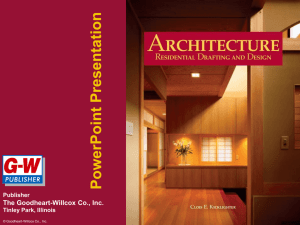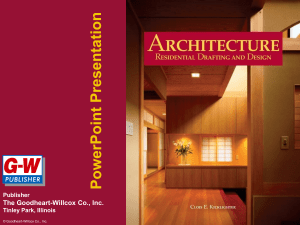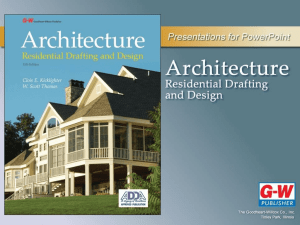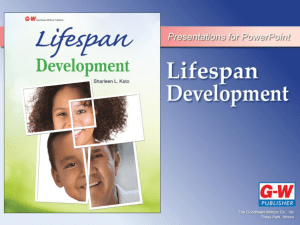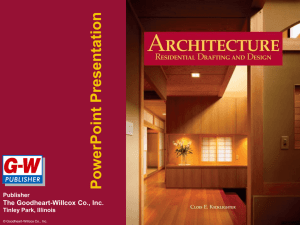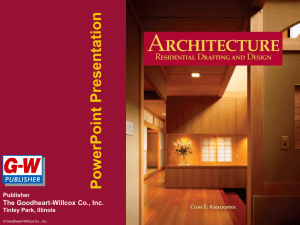C6 PPT
advertisement
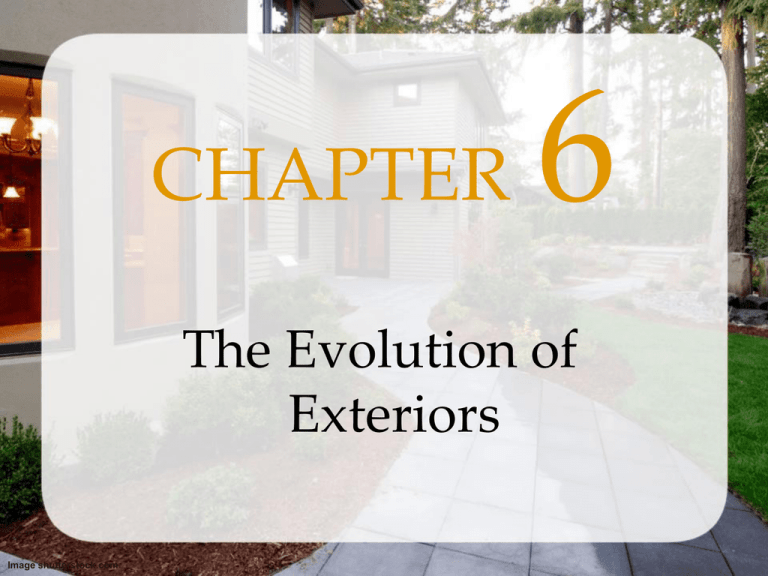
CHAPTER 6 The Evolution of Exteriors Image shutterstock.com Objectives • Summarize the development of exterior architectural styles throughout history, including Traditional, Modern, Contemporary. • Compare and contrast historical architectural and housing styles. © Goodheart-Willcox Co., Inc. Permission granted to reproduce for educational use only. Exterior Evolution • The exteriors have evolved over time • Settlers brought with them their ideas of what houses should look like • The homes usually grouped by style and time period © Goodheart-Willcox Co., Inc. Permission granted to reproduce for educational use only. Traditional Houses • Traditional homes are grouped into two major categories, including – folk houses – classic houses © Goodheart-Willcox Co., Inc. Permission granted to reproduce for educational use only. Traditional Folk Houses • Affected by – climate – geographical area – ethnic experiences – lifestyle of the occupants – available natural resources continued © Goodheart-Willcox Co., Inc. Permission granted to reproduce for educational use only. Traditional Folk Houses • Traditional folk houses included – Native American – Early English – Spanish – Scandinavian – German – Dutch – French © Goodheart-Willcox Co., Inc. Permission granted to reproduce for educational use only. Native American • Native American housing – Pueblo in New Mexico, which was copied by settlers • Box-like construction, flat roofs, and projecting roof beams ©gary yim/Shutterstock.com © Goodheart-Willcox Co., Inc. Permission granted to reproduce for educational use only. Early English • Began in the early 1600s • Many used half-timbered design because – colonies had much available wood • Early English styles also include – Tidewater South – New England style continued © Goodheart-Willcox Co., Inc. Permission granted to reproduce for educational use only. Early English • The Tidewater South style was – built along coastal regions – raised to keep the water (tide) from coming in • Had fireplaces on each end of the house and porch to one side continued © Goodheart-Willcox Co., Inc. Permission granted to reproduce for educational use only. Early English • New England styles include – Cape Cod which features a symmetrical design and a dormer (or two) on top – Saltbox which features a slanted back roof following the shape of salt boxes of the time ©Gregory James Van Raalte/Shutterstock.com ©Dee Golden/Shutterstock.com © Goodheart-Willcox Co., Inc. continued Permission granted to reproduce for educational use only. Early English • Another New England style included the Garrison, featuring – a second floor that juts out over the main entrance for protection against theives ©littleny/Shutterstock.com © Goodheart-Willcox Co., Inc. Permission granted to reproduce for educational use only. Spanish • The Spanish style uses – adobe brick and stone covered with stucco – an asymmetrical style ©Michelle Marsan/Shutterstock.com © Goodheart-Willcox Co., Inc. Permission granted to reproduce for educational use only. Scandinavian • The Scandinavians include people from Sweden, Finland, Norway, and Denmark • In the 1700s, the Scandinavians brought – the log cabin design to North America • Gable roof is very steep so that snow will fall off the roof ©David P. Smith/Shutterstock.com © Goodheart-Willcox Co., Inc. Permission granted to reproduce for educational use only. German • The Germans arrived in the late 1600s • German homes were – large and durable – made of wood and fieldstone – two stories • Some homes had a pent roof, or – a small ledge between the first and second floor © Goodheart-Willcox Co., Inc. Permission granted to reproduce for educational use only. Dutch • The Dutch brought the Dutch Colonial style to North America – A main feature is the gambrel roof ©Cynthia Farmer/Shutterstock.com © Goodheart-Willcox Co., Inc. Permission granted to reproduce for educational use only. French • The French settled in the 1700s and brought the styles of – French Normandy – French Plantation – French Manor • The French Manor has a characteristic Mansard roof (a gambrel variation) • The French also brought the French Provincial style © Goodheart-Willcox Co., Inc. Permission granted to reproduce for educational use only. Classic Traditional Houses • Prosperity in the colonies brought refinement to the housing styles and thus began these styles • The Classic traditional housing includes – Georgian – Federal – Greek Revival – Southern Colonial – Victorian © Goodheart-Willcox Co., Inc. Permission granted to reproduce for educational use only. Georgian • The Georgian style (1690–1800) was influenced by English architecture • A feature of Georgian style is the – hip roof – dentil molding ornamentation under the eaves ©stefano spezi/Shutterstock.com © Goodheart-Willcox Co., Inc. Permission granted to reproduce for educational use only. Federal • The Federal style grew out of patriotism after the American Revolution – The home features are symmetrical and include a box-like shape and two or more stories – Two styles emerged during this period • Adam Style • Early Classical Revival continued © Goodheart-Willcox Co., Inc. Permission granted to reproduce for educational use only. Federal • The Adam style included a Palladian window over the door that looks like a fan • Early Classical Revival used Greek and Italian details ©1000 Words/Shutterstock.com © Goodheart-Willcox Co., Inc. Permission granted to reproduce for educational use only. Greek Revival • The Greek Revival style duplicated design elements of ancient Greek architecture, including columns around doorways – A famous example is Monticello, the home of former president Thomas Jefferson ©spirit of america/Shutterstock.com © Goodheart-Willcox Co., Inc. Permission granted to reproduce for educational use only. Southern Colonial • The Southern Colonial is an offshoot of the Greek Revival style with such characteristics as – two or three stories – symmetrical design – hip or gable roof – dormers and shutters – a belvedere © Goodheart-Willcox Co., Inc. Permission granted to reproduce for educational use only. Victorian • The Victorian style followed the American Civil War • Industrial Revolution brought machines and mass production to make fine wood cutting designs which showed up in designs continued © Goodheart-Willcox Co., Inc. Permission granted to reproduce for educational use only. Victorian • A good example of one type of Victorian home is the Queen Anne design – The turret is a feature of the Queen Anne style ©Donald J. Price/Shutterstock.com © Goodheart-Willcox Co., Inc. Permission granted to reproduce for educational use only. Modern Houses • Modern style houses were developed in the U.S. between the 1900s and 1980s • Modern styles include – Prairie Style – Arts and Crafts – Bungalow – International Style – Ranch and Split-Level © Goodheart-Willcox Co., Inc. Permission granted to reproduce for educational use only. Prairie Style • The Prairie style house was designed by Frank Lloyd Wright, considered one of the greatest architects in America • Prairie style features include – strong horizontal lines – low-pitched roofs – overhanging eaves continued © Goodheart-Willcox Co., Inc. Permission granted to reproduce for educational use only. Prairie Style • Other features of the Prairie style include – an open floor plan – visual interaction with the outdoors ©Mario Savoia/Shutterstock.com © Goodheart-Willcox Co., Inc. Permission granted to reproduce for educational use only. Arts and Crafts • The Arts and Crafts style house is also called a Craftsman house • As a reaction against the ornate Victorian houses that preceded them, Arts and Crafts homes featured – simple and natural lines – low-pitched roof with wide eaves – wood, stone, or stucco siding © Goodheart-Willcox Co., Inc. Permission granted to reproduce for educational use only. Bungalow • The Bungalow is a example of the Arts and Craft movement, and its typical features include – a porch along the front – an open floor plan – one and a half stories – horizontal shape – exterior made of wood or brick © Goodheart-Willcox Co., Inc. Permission granted to reproduce for educational use only. International Style • The International style is the most dramatic of the modern style houses • International houses feature – simplicity in design – geometric lines – large expanses of glass windows – flat rooftops with rooftop gardens © Goodheart-Willcox Co., Inc. Permission granted to reproduce for educational use only. Ranch • A ranch house is a one-story home that may have a basement and includes – low-pitched roof with an overhang • The style began on ranches where land was abundant ©Donald Joski/Shutterstock.com © Goodheart-Willcox Co., Inc. Permission granted to reproduce for educational use only. Split-Level • A split-level home has 3 or 4 levels • Quiet social areas • Service areas that are easily separated ©Goodheart-Willcox Publisher © Goodheart-Willcox Co., Inc. Permission granted to reproduce for educational use only. Contemporary Houses • Contemporary style houses are those that are constructed today • The variety of styles is not easily categorized, however, contemporary houses include – solar houses – earth-sheltered houses © Goodheart-Willcox Co., Inc. Permission granted to reproduce for educational use only. Solar Houses • Solar houses use systems and techniques that utilize energy from the sun • Active solar heating systems use special equipment, such as motors and fans to attract and use solar energy • Passive solar heating systems have no working parts and rely on direct sunlight on materials to attract and store solar energy, such as large windows and dark walls © Goodheart-Willcox Co., Inc. Permission granted to reproduce for educational use only. Discuss • Solar homes use the sun to generate electricity, to heat the hot water, and to heat the space ©Rob Bryan/Shutterstock.com What features of this solar home make it energy efficient? Image shutterstock.com © Goodheart-Willcox Co., Inc. Permission granted to reproduce for educational use only. Earth-Sheltered Houses • Earth-sheltered houses are partially covered with soil • The soil helps – insulate the house – protect the house from the elements (wind, low temperatures) © Goodheart-Willcox Co., Inc. Permission granted to reproduce for educational use only. Postmodern Houses • Postmodern houses began in the 1970s and continue today • The features – are diverse with a sense of “less is more” – have a “wit” and can be bizarre or shocking – include unexpected and playful elements © Goodheart-Willcox Co., Inc. Permission granted to reproduce for educational use only. Discuss • Postmodern homes are unique and diverse ©bbbb/Shutterstock.com What features are unusual about this house? Image shutterstock.com © Goodheart-Willcox Co., Inc. Permission granted to reproduce for educational use only. Recap • Many exterior housing styles exist in the United States, including styles that – evolved from Native Americans – settlers brought from their homelands • Traditional folk styles include – Native American, Spanish, Scandinavian, Dutch, German, French, and English • Early English styles also included the Cape Cod, Saltbox, and Garrison styles continued Image shutterstock.com © Goodheart-Willcox Co., Inc. Permission granted to reproduce for educational use only. Recap • Classic Traditional styles evolved during Colonial times, including such styles as – Georgian – Federal and Adam – Early Classical Revival – Greek Revival – Southern Colonial – Victorian continued Image shutterstock.com © Goodheart-Willcox Co., Inc. Permission granted to reproduce for educational use only. Recap • Modern and contemporary housing appeared in the 20th century • These houses were designed to – take advantage of the environment – fit changing lifestyles • Modern houses include – Prairie style – Arts and Crafts, bungalow – International continued Image shutterstock.com © Goodheart-Willcox Co., Inc. Permission granted to reproduce for educational use only. Recap • Styles of contemporary housing built today vary greatly, but may include – earth-sheltered and solar houses • Contemporary homes may use traditional features in a unique, distinctive way • Postmodernism combines – features of past housing with a new look that is sometimes jarring to the viewer continued Image shutterstock.com © Goodheart-Willcox Co., Inc. Permission granted to reproduce for educational use only.
